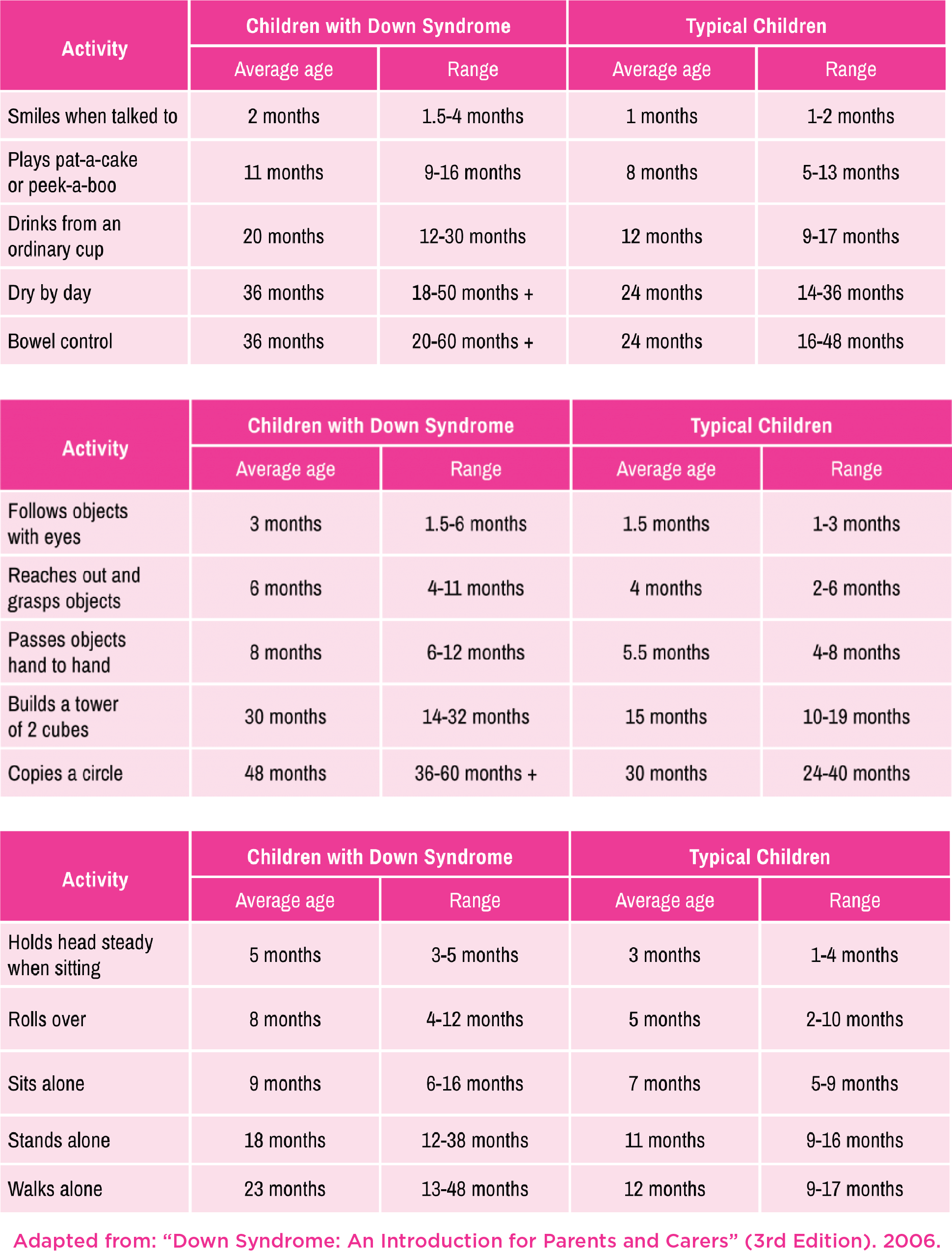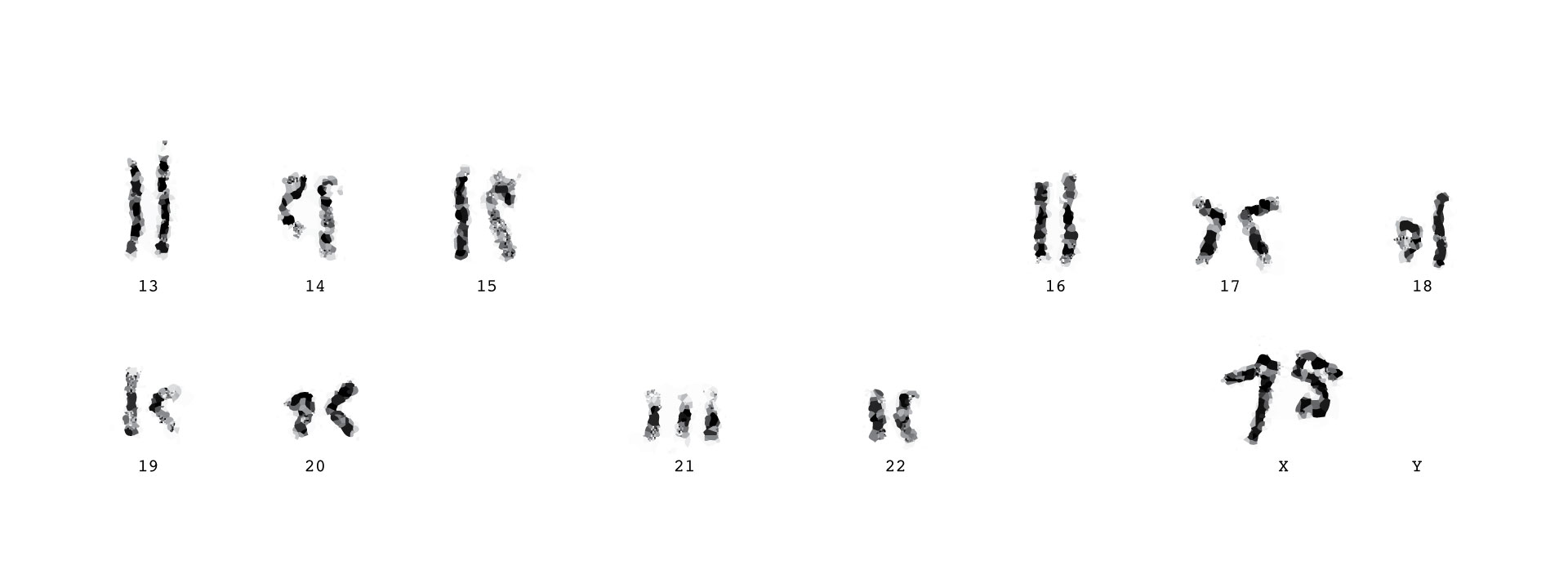DS is a genetic abnormality in which there is an extra 21st chromosome or extra material on the 21st chromosome. DS is the most common chromosomal abnormality in humans and occurs in about 1 in 700 live births. It is characterized by certain physical traits such as upslanted eyes and a palmar crease in the palm of the hand as well as mental traits such as impaired cognitive function. DS has various associated health conditions including cardiac defects, thyroid imbalances, as well as ocular and hearing impairments. These should be tested for at birth. There is a spectrum of the severity of DS that can be influenced by factors including access to therapy and early intervention services.
DS is the most common chromosomal abnormality in humans and occurs in about 1 in 700 live births.
Down Syndrome is the result of a chromosomal irregularity that occurs during conception. Increased maternal age is considered a risk factor for DS. However, most babies with DS are born to young mothers. Moreover, nothing that a mother, or father for that matter, did before, at or after the time of conception is considered to cause DS. In other words, it is not a mom or dads fault and many parents feel they are blessed by having a child with the syndrome.
Most often, DS is caused by a phenomenon called non-disjunction that results in three rather than two chromosomes on the 21st chromosome. To break that down, chromosomes carry DNA which is the genetic material that gets inherited from each parent. There are 22 autosomal chromosomes that carry the DNA that codes for everything from eye color to height and there are 2 sex chromosomes. During conception of a fetus, the design is for the mother to pass half of her genetic material to the baby and, likewise, for the father to pass half of his genetic material to the baby. In turn, the plan is for the baby to get one chromosome from the mom and one from the dad for all of the 22 autosomal chromosomes.
There is a spectrum of the severity of DS that can be influenced by factors including access to therapy and early intervention services.
In the case of DS caused by non-disjunction, rather than each parent giving one chromosome for the chromosome numbered 21, one parent gives 2. The result is a trisomy on the 21st chromosome, ie the baby has an extra chromosome and has DS. Less commonly, there is a mosaic type of DS in which the same process of non-disjunction occurs, however, it does not happen in every cell. As a result, some cells have 3 copies of chromosome 21, while other cells have the normal amount of 2 copies. Additionally, there is DS caused by a translocation.
A translocation occurs when a piece of another (not #21) breaks off and joins with the 21st chromosome. Generally, it is chromosome 14 that donates the extra piece to the 21st chromosome. With the extra material on #21, the diagnosis of DS is made and it is confirmed by karyotype.
SEE IMAGE BELOW, 3 CHROMOSOMES ON #21.
According to the National Institute of Health, NIH:
Physical therapy (PT), occupational therapy (OT), and speech therapy can be helpful in kids with DS. DS babies and kids often delay in achievement of milestones and can also differ in the order in which they progress developmentally compared with typical babies. These differences arise from the abnormal chromosomal makeup as well as features of DS including low muscle tone, or hypotonia, hypermobility of joints, balance disturbances and commonly associated cardiac, vision, hearing, thyroid and other defects. Fortunately, there is a likely to be a positive correlation between early intervention and therapy with improved long-term outcomes in DS.
PHYSICAL THERAPY
Physical Therapy is intended to improve gross motor movements. In DS, the primary goal of PT is to help normalize movements and to limit the extent to which babies and kids use compensatory movements. It is not the goal to accelerate the rate of milestone achievement. Because of factors listed above including low muscles tone, babies and kids with Down compensate when learning to sit, walk, climb stairs, and so forth. If left without intervention, these compensatory movements can lead to health complications such as kyphosis, a hunched back, knee pain, and feet problem, to name a few. Therefore, PT helps to properly teach these gross movements and in turn provide for healthier and improved lives. Of note, a physician must clear a baby for PT in order for the therapy to commence.
The primary goal of Physical Therapy is to help normalize movements and to limit the extent to which babies and kids use compensatory movements. Also helps to properly teach these gross movements and in turn provide for healthier and improved lives.
OCCUPATIONAL THERAPY
Occupational Therapy works with gross and fine motor movements, sensory awareness, self-care, and skills necessary for one’s occupation. For babies in kids with DS, OT assists in achieving milestones while emphasizing fine motor movements including use of arm and hand movements. OT is generally introduced in infancy at about 6 months of age
SPEECH THERAPY
Speech is important in DS starting in infancy as feeding and oral motor therapy. The same muscles used in feeding ultimately are used to speak, as such speech therapy can begin when the baby is a newborn. In infancy, pre-speech skills such as visual skills, cognitive skills and auditory skills are addressed. Moreover, along with low muscle tone, hearing loss, often secondary to liquid in the middle ear, is extremely common in DS and can negatively impact speech. Addressing hearing concerns are an important component to speech and should be evaluated by an otolaryngologist (ENT). Additionally, the use of sign language is often encouraged in DS as a means of communication.
There is no such thing as a typical child with Down Syndrome. Children with the syndrome are as different from each other as are all children. However, by and large, their development is slower than that of most children. The charts which follow give the usual development progress of children with the syndrome. By understanding what is usual for a child with Down syndrome you will be able to recognize any additional problems at an early stage.

Adapted from: “Down Syndrome: An Introduction for Parents and Carers” (3rd Edition). 2006.

![]() +1 (787) 534-3487
+1 (787) 534-3487
+1 (787) 675-2211
OUR MISSION
Lily’s Angels & Down Syndrome Awareness Foundations is a non-profit dedicated to bringing awareness about Down syndrome as well as increasing access to therapy.